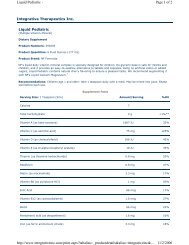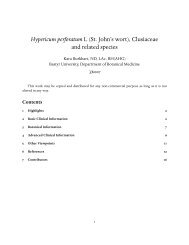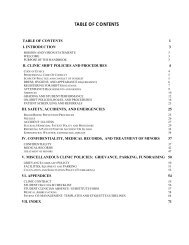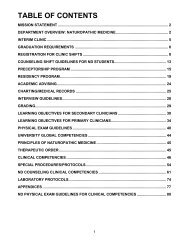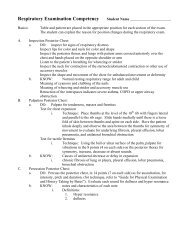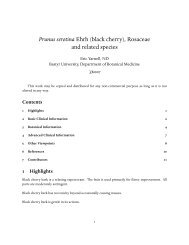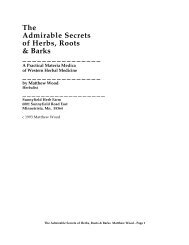Cinchona officinalis L (Peruvian bark), Rubiaceae ... - AaronsWorld
Cinchona officinalis L (Peruvian bark), Rubiaceae ... - AaronsWorld
Cinchona officinalis L (Peruvian bark), Rubiaceae ... - AaronsWorld
Create successful ePaper yourself
Turn your PDF publications into a flip-book with our unique Google optimized e-Paper software.
great care is exercised in the cultivation. The trees are allowed to reach the age of twelve years before<br />
the <strong>bark</strong> is collected. The cultivation is largely confined to the variety Ledgeriana. Over 500,000<br />
pounds are collected annually from Java plantations.<br />
DESCRIPTION.In quills or curved pieces of variable size, usually 2 or 3, sometimes 5 mm. thick;<br />
externally gray, rarely brownish-gray, with numerous intersecting transverse and longitudinal fissures,<br />
having nearly vertical sides; the outer <strong>bark</strong> may be wanting, the color externally being then cinnamon<br />
brown; the inner surface light cinnamon brown, finely striate; fracture of the outer <strong>bark</strong> short and<br />
granular, of the inner finely splintery; powder light brown or yellowish-brown; odor slight, aromatic;<br />
taste bitter and somewhat astringent.<br />
MICROSCOPICAL.The calisaya (variety Micrantha) transversely shows milk-vessels in the cortical<br />
parenchyma and absence of stone cells, which are present in Lancifolia. The rays of the woody<br />
portion are more elongated and the medullary rays larger in size. Bast fibers comparatively small and<br />
less numerous, but are spindle-shaped, as they are in all true cinchona <strong>bark</strong>s showing longitudinal<br />
section. In C. rubra the stone cells and milk-ducts are both wanting, while the bast fibers are more<br />
numerous and stouter. The <strong>bark</strong> is richer in coloring matter. In cuprea <strong>bark</strong> the cork cells are thicker<br />
and the cortical parenchyma cells smaller, stone cells present, milk-ducts absent, few bast fibers, but<br />
the woody portion contains indurated cells, which simulate them. The ligneous cells are very numerous<br />
and extend even down into the medulla. They are smaller than the bast fibers of true cinchona<br />
<strong>bark</strong>s, but much more numerous.<br />
These <strong>bark</strong>s are thoroughly saturated with pigments, principally cinchona red, the phlobaphen<br />
of all cinchona <strong>bark</strong>s. Before microscopical examination these pigments must be removed by a weak<br />
alcoholic solution of ammonia. This requires considerable practice (Dohme). Compared with other<br />
<strong>bark</strong>s, the fibers of the liber of cinchona are shorter and more loosely arranged, being for the most<br />
part separated into simple fibers imbedded in the bast parenchyma, or united into very short bundles.<br />
Grahe’s test for the distinction of cinchona <strong>bark</strong> is as follows: On heating about 0.1 Gm. (1.5 gr.) of<br />
the powdered <strong>bark</strong> in a dry test-tube a tarry distillate of a red color is obtained.<br />
Powder.Microscopical elements of: See Part iv, Chap. I, B.<br />
OFFICIAL PREPARATIONS.<br />
Fl. Ext. <strong>Cinchona</strong>e, Dose: 15 drops (1 mil).<br />
Tr. <strong>Cinchona</strong>e , 1 fl. dr. (4 mils).<br />
532a. CINCHONA RUBRA.The dried <strong>bark</strong> of <strong>Cinchona</strong> Succirubra Pavon (more) or its hybrids,<br />
yielding not less than 6 per cent. of the total alkaloids of <strong>Cinchona</strong>. ”In quills or incurved pieces,<br />
varying in length, and from 2 to 4 or 5 mm (1/12 to 1/6 or 1/5 in.) thick; the outer surface covered<br />
with a grayish-brown cork, more or less rough from warts and longitudinal, warty ridges, and from<br />
few, mostly short and not frequently intersected transverse fissures, having their sides sloping; inner<br />
surface more or less deep reddish-brown and distinctly striate; fracture short, fibrous in the inner layer;<br />
outer layer, granular. For years practically all of the red cinchona <strong>bark</strong>, so called, was only a hybrid, but<br />
recently, and especially for a year past, fine quill <strong>bark</strong> of pure succirubra has frequently been received.<br />
Powder.Microscopical elements of: See Part iv, Chap. I, B.<br />
CONSTITUENTS.Upon quinine, C20H24N2O23H2O, the <strong>bark</strong> almost exclusively depends for its<br />
value. This alkaloid is colorless, amorphous, or in acicular crystals; inodorous, very bitter; soluble in<br />
1670 parts water, 6 parts alcohol, 26 parts ether. Aqueous solutions of the salts have a blue fluorescence,<br />
12



